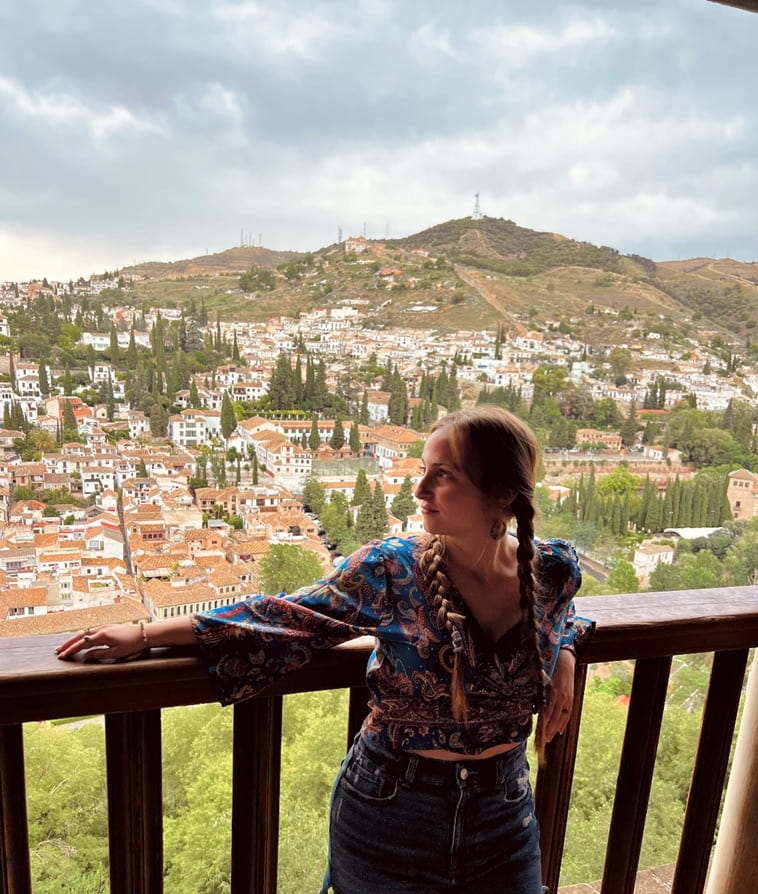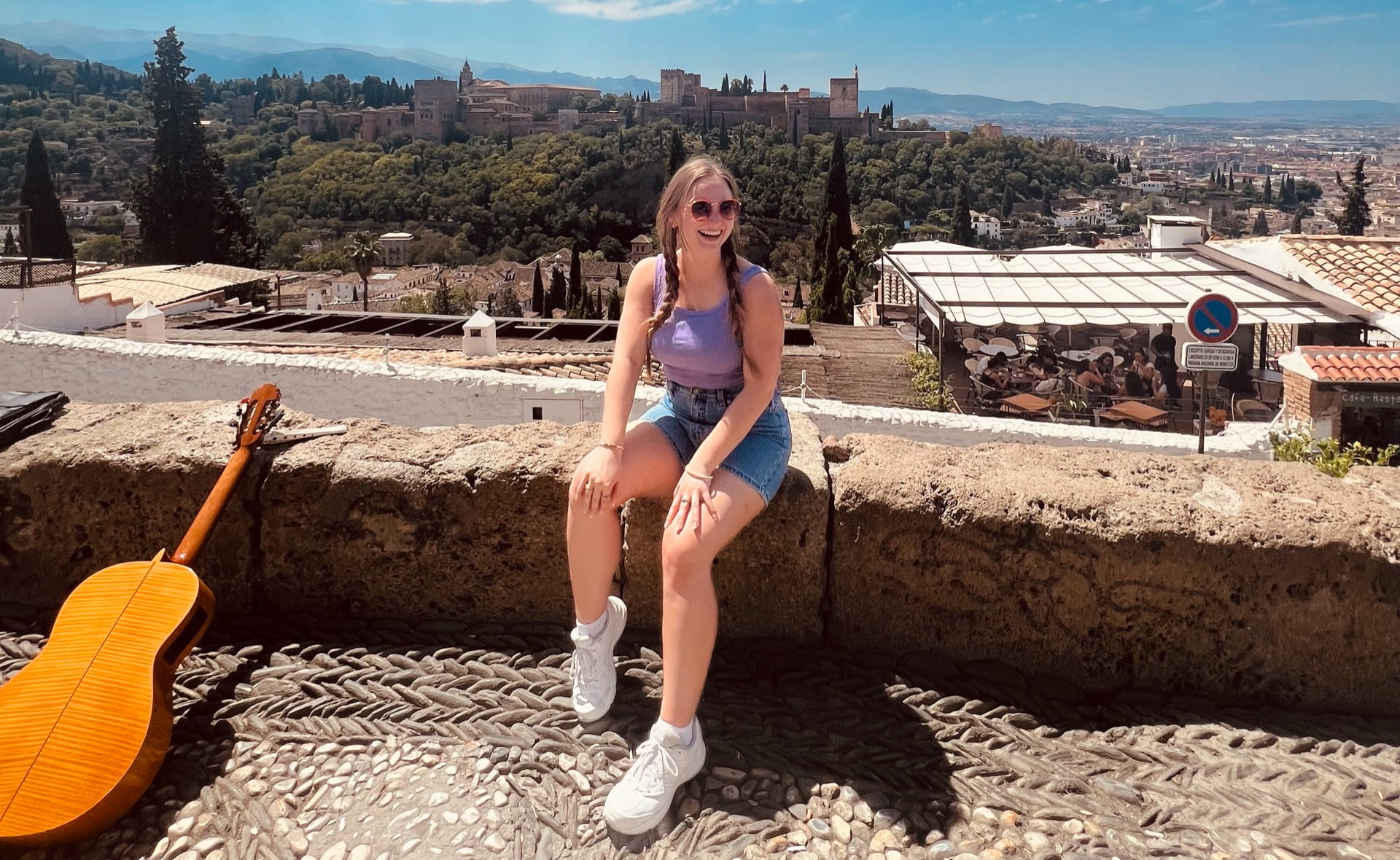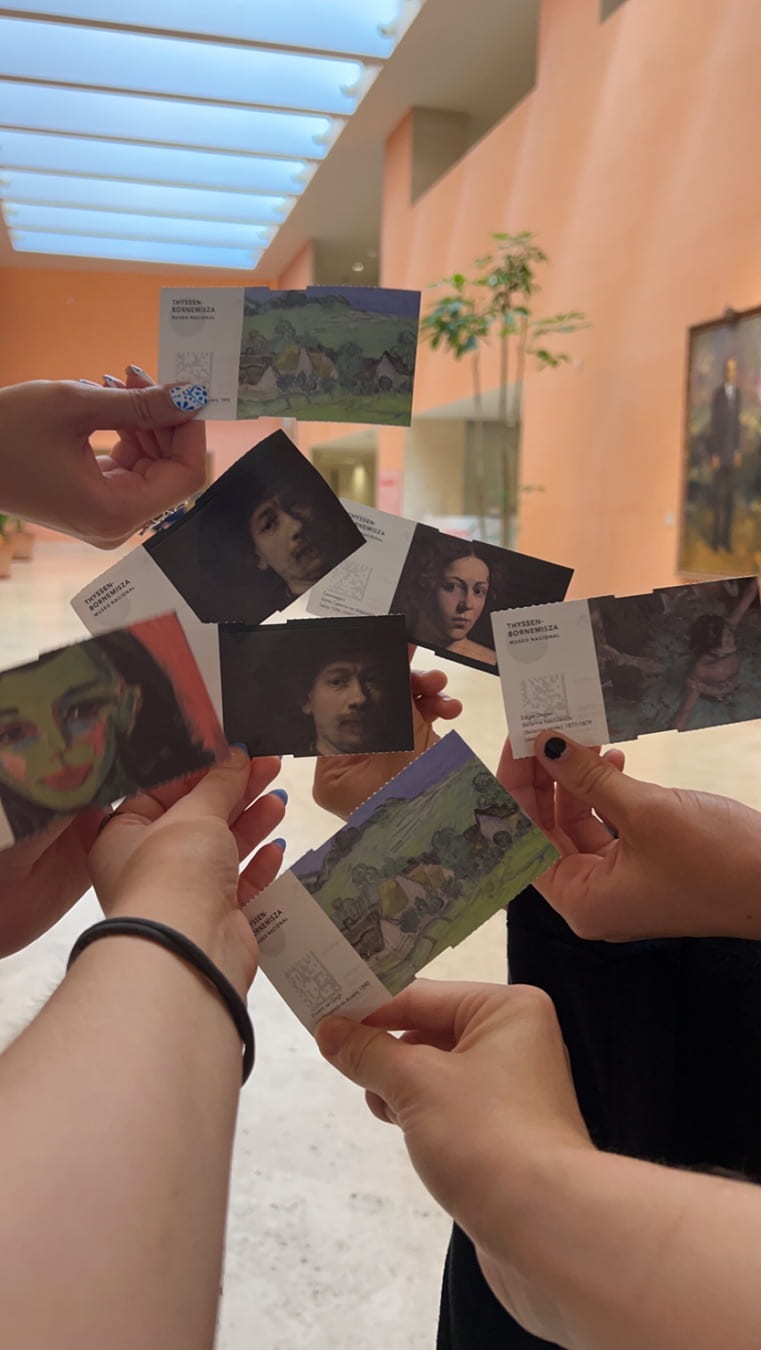Savanah Godwin is an Honors College Fellow from Hot Springs, AR, majoring in chemical engineering and minoring in Spanish. She studied abroad in Madrid last summer and discovered the benefits of a slower pace to life filled with breaks to reset one’s focus.

Here’s a picture I took inside the Alhambra. It was a stunning view of the quaint Granada city, with rust-colored rooftops and speckles of trees dotting the sight.
My interest in Spain was sparked when I started learning Spanish in high school. It is where the language originated and so it was only natural that I developed a curiosity for the country. I decided to study abroad there in the summer of 2023 to improve my Spanish skills since it has always been a goal of mine to be fluent. On a professional level, I also hope to travel and learn about their sustainability and energy production since I plan to get an advanced degree in environmental engineering. I would like to travel to Costa Rica, which produces 100% renewable energy, and speaking Spanish well would help me in that endeavor. What better way to improve my Spanish than to launch myself headfirst into a country where that is its official language?
Upon arriving, I quickly realized I was not as prepared to communicate in Spanish as I thought. I was yelled at in the Madrid airport while in line for coffee but completely missed what was being said to me! I laughed it off, but after that experience, I had never been so relieved to start classes. I needed to drastically improve my speaking skills!

This is the Sagrada Familia in Barcelona Spain. It is still under construction after centuries, designed by Antonio Gaudí, but that doesn’t stop the eye from being captured by its architecture. It is the largest unfinished Catholic church in the world.
I went to Antonio de Nebrija University, which was a very different experience than the University of Arkansas. Compared to my classes with 200-300 people in Organic Chemistry, these classes were tiny with 10 to 20 people. I was able to form an extremely close relationship with my professors and my classmates. The classes were driven largely by conversation: the professor simply talking along with us about lessons they were teaching, ensuring that each class was interactive. This allowed me to stay attentive in class. The professors solely wanted their students to succeed and the assignments and exams were very clearly meant to help us learn and improve. Also, since the classes I was taking lasted a month as opposed to a semester, they were each two hours every day. Four hours straight was spent in school. I was surprised to realize that we were gifted a ten-minute break every fifty minutes. I was not accustomed to being able to refresh and reset at Arkansas and taking “pausas” helped me to remain focused throughout the four hours. School in the United States throughout my whole life had been a great source of stress for me. However, this manner of teaching made me excited about learning and relieved as I could have a safe place to make mistakes outside of the “real world.”
My daily routine in Spain consisted of going to class in the mornings and then having the rest of my day for cultural activities and exploring. If I was to sum up my experience of Madrid in one sentiment, I would say that it is a city created and designed for humanity. Any place that I needed to go was within walking distance because the city was built before cars. I was consistently getting exercise and sun, solely because I had to walk every day to get anywhere. An unexpected perk of this is that there were dogs everywhere, because people just take them on walks as they walk. I was constantly asking to pet strangers’ dogs and was constantly in a good mood because of it! For places that are further away, I used the public transportation system which is inexpensive and easy for madrileños to navigate.
Something that I noticed immediately was that there were lines and bumps all over the ground in Madrid. I didn’t realize what they were at first until I saw people using them to guide their canes. I then started to notice there were ramps everywhere and wheelchair accessible areas even on the metros. The crosswalks have loud noises that play to notify people to cross the street. Madrid has put so much energy into being as accessible as possible for people with different kinds of disabilities. The city is built for all kinds of people, fostering a kind of safe haven for all.
Additionally, the food in Spain is meant to cause fulfillment and health. Even in fast-food places everything must be locally sourced; it is fresher, healthier, and doesn’t have unnecessary chemicals. It was jarring to drink plain orange juice for the first time here. It was natural, fresh, and real, making “Simply Orange” taste exactly like what it is: fake sugar with drops of orange concentrate.

This was the Albacín neighborhood in Granada, Spain. We came up to view the city, and the sights were gorgeous.
The work-life balance in Spain is very different than in the United States. There are “siesta” hours every day that can start as early as 2pm and last up until 8pm. This is a time when most stores are closed. If I needed to go somewhere, I needed to check to make sure they were open! I can’t remember the number of times I had walked somewhere only to find they were closed due to siesta hours. These times were meant to give Spaniards a rest and reset time. The attitude towards their jobs is drastically different as well. People in Spain have much more paid vacation time than the United States. I was consistently reminded that in the United States people live to work while in Spain people work to live. I would see people in suits sitting outside a bar drinking a beer with a friend at 3pm, which is unheard of in the United States.

This was a visit to the Thyssen-Bornemisza Museum in Madrid. It is one of the lesser-known museums in Madrid, and the collections were as unique as they were breathtaking.
I was also able to have a myriad of new cultural experiences. When I went to the Reina Sofia, I was able to see paintings in person that I have only learned about in classrooms. Salvador Dalí and Pablo Picasso are two of my favorite famous artists. I turned into a “fangirl,” utterly in awe that I was able to experience art like Guernica with my own eyes. Spain is also known for its “mercados.” The largest and most well-known is El Rastro. It is an open-air flea market in Madrid that occurs every Sunday. The road is blocked off for the day so people can stroll along the booths, listening to prices being called out and gambling in their heads if there will be a better price further down the road.
Although Spain has incredible food, the first thing that I did when I returned home is ate some Chick-fil-a in an air-conditioned restaurant. There was a lack of air conditioning throughout Spain, and I missed my Chick-fil-a runs in the United States. For anyone who wants to go to Madrid or Spain in general, my advice is to just do it. I had never traveled outside of the country before, let alone traveled by myself, so I was an anxious mess before leaving. I was out of my comfort zone in a new country and new language. However, it was worth pushing through the unknown to experience all that Spain offered. I wish that I had understood beforehand that friends are a guarantee, as I never felt lonely, and eventually the unknown becomes known.
